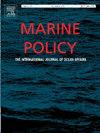Perspectives on beach seine fishing in the Western Indian Ocean: A review
IF 3.7
2区 社会学
Q2 ENVIRONMENTAL STUDIES
引用次数: 0
Abstract
Beach seine fishing ranks among the most destructive in shallow coastal ecosystems worldwide, resulting in overfishing, habitat destruction, and biodiversity loss. Despite regulatory measures, illegal fishing continues across the Western Indian Ocean (WIO). This review gathers insights on beach seine fishing in the region from scientific papers and grey literature published over 30 years, from 1994 to 2024. We examine the historical evolution and document reported evidence on the ecological effects, management responses, socioeconomic considerations, and governance challenges associated with the fishery. The introduction of beach seine fishing in the region dates back to the 1650 s in South Africa and expanded to the entire region, with the most recent introduction occurring in Madagascar in the 1960s. Studies reporting catch characteristics, such as yield, species composition, and size distribution, were numerous, representing 81 % of the publications. However, quantitative assessments of broader ecological and socio-economic impacts were limited. Diverse management measures implemented, including complete bans (in Kenya, Tanzania and Madagascar), gear-based spatial and seasonal closures (in Mauritius, Mozambique, and South Africa), and technical restrictions on gear dimensions and use (in Mozambique, Mauritius, South Africa, and the Seychelles). Fishing gear exchange programmes have had varying levels of success, but remain the most promising. Drawing on experiences and lessons from the region and beyond, we outline a practical roadmap of actions implemented to phase out destructive fishing practices effectively. We advocate for long-term, holistic and multifaceted actions that foster community-led transitions while balancing ecological sustainability with socio-economic resilience.
西印度洋海滩围网捕鱼的展望:综述
海滩围网捕鱼是世界上最具破坏性的浅海生态系统之一,导致过度捕捞、栖息地破坏和生物多样性丧失。尽管采取了管制措施,西印度洋的非法捕鱼活动仍在继续。这篇综述收集了从1994年到2024年30多年来发表的科学论文和灰色文献中对该地区海滩围网捕鱼的见解。我们研究了历史演变,并记录了与渔业相关的生态影响、管理对策、社会经济因素和治理挑战的报告证据。该地区引入海滩围网捕鱼的历史可以追溯到1650年 年代的南非,并扩展到整个地区,最近一次引入是在20世纪60年代的马达加斯加。报告捕获特征的研究,如产量、物种组成和大小分布,数量众多,占出版物的81% %。然而,对更广泛的生态和社会经济影响的定量评估是有限的。实施了多种管理措施,包括完全禁止(肯尼亚、坦桑尼亚和马达加斯加),基于齿轮的空间和季节性关闭(毛里求斯、莫桑比克和南非),以及对齿轮尺寸和使用的技术限制(莫桑比克、毛里求斯、南非和塞舌尔)。渔具交换方案取得了不同程度的成功,但仍然是最有希望的方案。根据本地区及其他地区的经验教训,我们概述了一份切实可行的行动路线图,以有效地逐步淘汰破坏性捕捞做法。我们提倡长期、全面和多方面的行动,促进社区主导的转型,同时平衡生态可持续性和社会经济弹性。
本文章由计算机程序翻译,如有差异,请以英文原文为准。
求助全文
约1分钟内获得全文
求助全文
来源期刊

Marine Policy
Multiple-
CiteScore
7.60
自引率
13.20%
发文量
428
期刊介绍:
Marine Policy is the leading journal of ocean policy studies. It offers researchers, analysts and policy makers a unique combination of analyses in the principal social science disciplines relevant to the formulation of marine policy. Major articles are contributed by specialists in marine affairs, including marine economists and marine resource managers, political scientists, marine scientists, international lawyers, geographers and anthropologists. Drawing on their expertise and research, the journal covers: international, regional and national marine policies; institutional arrangements for the management and regulation of marine activities, including fisheries and shipping; conflict resolution; marine pollution and environment; conservation and use of marine resources. Regular features of Marine Policy include research reports, conference reports and reports on current developments to keep readers up-to-date with the latest developments and research in ocean affairs.
 求助内容:
求助内容: 应助结果提醒方式:
应助结果提醒方式:


